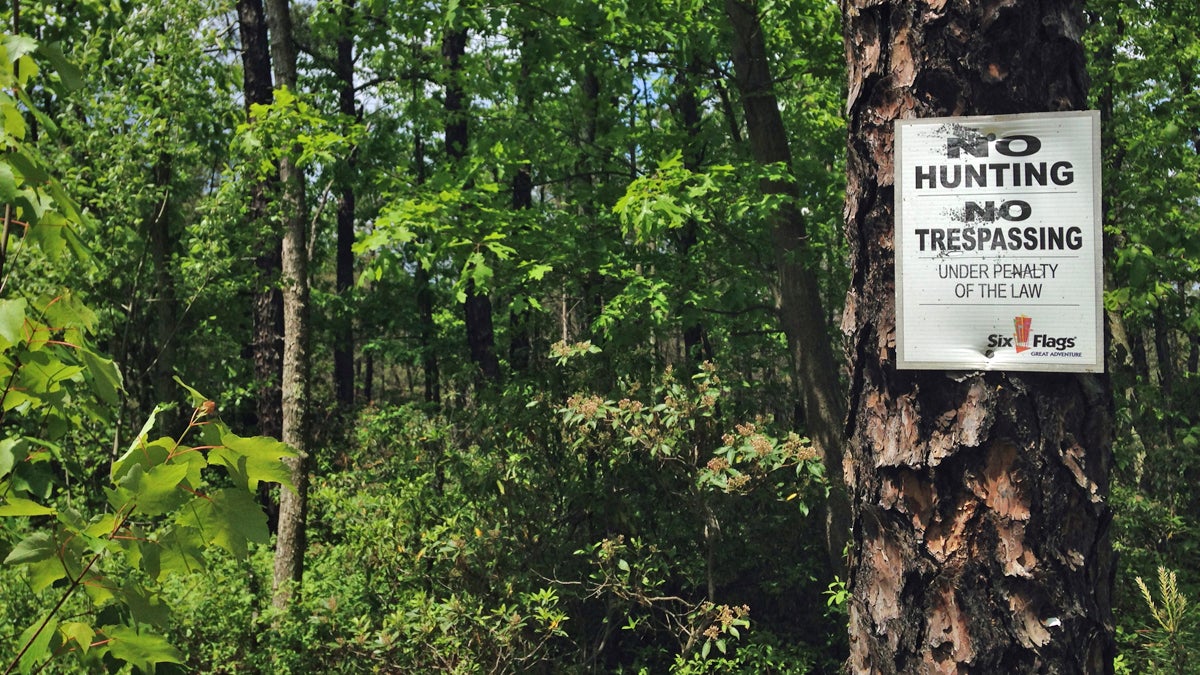Environmental groups not amused by Great Adventure plan to clear forest for solar installation
Listen
(Katie Hiler/for NewsWorks)
Summertime in Jackson, New Jersey, sounds like wheels creaking on metal rails — followed by screams of delight.
Six Flags Great Adventure is Jackson’s largest summer tourist destination, and also its biggest energy consumer. The park uses enough electricity to power more than 3,000 homes.
In March, Great Adventure received approval to build a 21.9-megawatt solar facility — the largest in the state — on 90 acres of park property. Expected to generate 98 percent of the park’s power needs, it comes at a cost — 18,000 trees must be cut down to accommodate it.
At the southeast end of the Great Adventure property sit 130 acres of undisturbed natural forest. On a recent day, Doug O’Malley, director of Environment New Jersey, walked along a sandy dirt road that cuts through the wooded area.
“We’re walking down Reed Road and on our left-hand side is the Pinelands National Reserve,” said O’Malley. “And on our right-hand side is the 90 acres that Great Adventure is targeting to bulldoze for their solar installation.”
The forest owned by Great Adventure looks exactly the same as the protected woods just across the road. The park purchased the land in 1974, four years before Congress created the Pinelands National Reserve. But until this solar project, Great Adventure seemed happy to leave the forest “as is.”
“We’ve seen hundreds of companies around the state go solar, and that’s a great thing,” said O’Malley. “But it’s not a great thing, and it’s setting an awful precedent, when you’re chopping down a forest to put up solar panels.”
Ninety acres may seem like a small area when compared with the 1.1 million acres protected in the Pinelands, and Great Adventure promises to plant 25,000 new trees. But environmentalists argue clear-cutting these 90 acres would disrupt a sensitive ecosystem that includes the Kirkwood-Cohansey aquifer, which supplies drinking water to a million.
Several environmental groups filed a lawsuit against Great Adventure and its solar installer, KDC, on the grounds that the plan was inconsistent with the town’s conservation laws.
“I have been for many years familiar with what I think is a very unfortunate conflict of these environmental goals,” said Michelle Donato, the land-use lawyer representing the environmental groups.
New Jersey offers renewable energy credits to those willing to invest in solar. With these kinds of financial incentives, Donato said, companies such as KDC can be shortsighted when it comes to the environmental impacts of a solar project.
“They just went slam-dunk for the theory that it’s better to have this power from solar that is to have the forest,” said Donato. “They didn’t consider alternatives.”
Solar parking lot one alternative
Those alternatives include building a solar farm above Great Adventure’s giant parking lot. The groups argue it would generate power and keep customers’ cars from baking in the summer sun. It’s a suggestion that’s been made both by environmental groups and the New Jersey Department of Environmental Protection, which offered to buy the land from Great Adventure back in May.
Great Adventure officials wouldn’t comment for this story and have not explained why it doesn’t consider building a solar canopy over its parking lot. But it may have something to do with the many challenges of installing this type of system.
“The issues dealing with a parking lot [are] you want to make sure that you are putting something in that is safe and durable and not interrupting the flow of traffic or the usability of the parking lot,” said David Froelich, the director of business development for Solaire Generation, the company that installed a canopy solar system over 28 acres of parking lot at Rutgers University.
It’s about 30 percent more expensive to install solar in a parking lot than in an open field, Froelich said, meaning it could take up to eight years to recoup the project costs.
Still, he said, there are reasons to consider choosing that approach.
“If you put solar into a parking lot, it’s still a parking lot, it’s just a better parking lot. One with shade, some protections from the elements and it’s a power plant,” said Froelich. “You know one of the things about putting solar onto a field is that it’s no longer a field; it’s now a solar farm.”
The parking lot of Great Adventure could use some shade. Ricardo Barreto and Alina Chaudhri were walking across the pavement in 88-degree heat to get to the park entrance. Barreto said he doesn’t like the idea of chopping down trees to go solar.
“It’s mixed feelings, but if they can do less than that or even none of it and get the solar power that would be good,” he said.
Environmentalists hope the lawsuit will delay Great Adventure long enough that Jackson residents rally against the plan.
WHYY is your source for fact-based, in-depth journalism and information. As a nonprofit organization, we rely on financial support from readers like you. Please give today.




